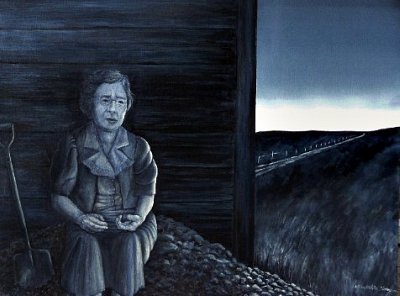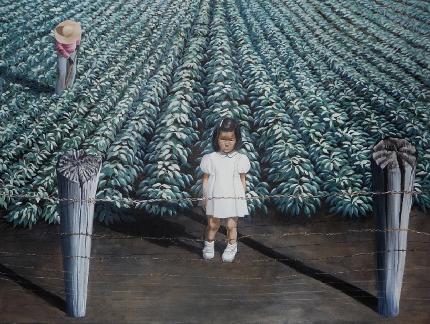EXPULSION 1942 - 1951
On Dec.7, 1941, Japan attacked the American naval base at Pearl Harbour in Hawaii. All Japanese Canadians living in British Columbia were forced by the Canadian government to leave their homes and possessions behind, and were relocated either to the interior of B.C., or to work on farms in Alberta. Citizens and non-citizens, those born in Canada and those born in Japan, grandparents, parents and children - all suffered the same fate. My family chose to go to Alberta to stay together as a family, rather than to an internment camp, where men were separated from their families and sent to hard labour in road camps. My parents toiled in the sugar-beet fields for ten hard years before we were able to go to Ontario for a better life. I was born in Alberta, towards the end of the war with Japan. This series of paintings is my personal tribute to the courage and tenacity of my parents and all of the Canadian families of Japanese ancestry who endured the indignity and shame of this calamitous experience.

Maki's World, Alberta, 1942 Acrylic on Canvas 30"x40"
Reiko, Alberta, 1945 Acrylic on Canvas 30" x 40"

Behind the Backyard Fence,Alberta,1948 Acrylic 30"x40"
Michiko, Alberta 1950 Acrylic on Canvas 30” x 40”
Shikata Ga Nai / It Can't be Helped, Alberta 1951 Acrylic 30" x 48"
Maki's World, Alberta, 1942
My grandmother hated Alberta. The landscape was flat and desolate. A stark contrast with the grandiose mountains of British Columbia and the ocean. And life was so hard! She became very depressed and would sit for hours on the coal, which was piled up against the house, staring westward, towards the mountains, towards the ocean. Her daughters would plead with her to come in, but often she did not even hear them.
Years before, Grandmother had been a picture bride from Japan, at the age of nineteen, to marry a man she did not know. She had given her life to be a Canadian. It must have been a devastating experience to her to have her freedom taken away so violently.
Reiko, Alberta, 1945
In February 1942, the government announced the forced evacuation of all 21,000 people of Japanese heritage living within 100 miles of the Pacific Coast. As a result, 2,700 Japanese people were sent to Alberta where labourers were needed in the sugar beet fields.
The Japanese Canadians who arrived in Alberta at this time were assigned to farms and not allowed to live in urban areas. My mom and her family endured horrible living conditions and were forced to do gruelling physical labour in the sugar beet fields from dawn until dusk.
In September, 1942, the restrictions placed on the Japanese-British Columbianswere also applied to the Japanese-Albertans: their mail and telephone calls were censored, and they were forced to
carry identity cards.
Behind the Backyard Fence,Alberta 1948
My mom was a city girl and had never toiled on a farm in her life. My mom is hoeing the weeds between the rows of sugar beets . The fields are huge, ten-acre lots. Mom and Dad worked ten acres all by themselves, seeding, thinning, hoeing and harvesting, while they looked after two small children. I am looking out through a barbed wire fence, which is reminiscent of a prison camp. My parents worked in the same fields alongside German prisoners of war, who were guarded by armed Canadian soldiers. Ironically we felt that we were also prisoners of war, although we had never fought against Canada. Although the war ended in 1945, we were not allowed to travel in Canada until 1951, when we went to Ontario in search of a better life.
Michiko, Alberta 1950
Here, I look out at the bitterly cold Alberta winter where temperatures often fell to -40 F. The shack to which my family were relocated from Vancouver in 1942, was a converted chicken coop, inadequate for the frigid conditions, and we were always cold.
One very cold winter, my dad went to work in a logging camp in B.C. to earn extra money for us. My mom had to melt snow to wash clothes, bathe us and cook because the well froze. They say wells never freeze, but it was so cold that ours did. A bucket of snow only produced one cup of water. It was an endless task for her, especially with two small children to look after.
Shikata Ga Nai / It Can't be Helped, Alberta 1951
This painting was my very first expression of my family's story.
It is my own memory of the sugar beet fields of Alberta, where my family toiled endlessly from dawn until dusk. I see myself, hiding behind my mama doll. My clean white dress contrasts sharply with this life of toil, and is a reminder of the city life my parents had to leave. My mother always put dresses on me.